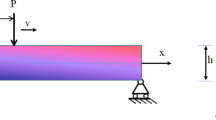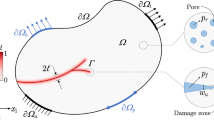Abstract
Following the total Lagrangian approach, an incremental formulation for three-dimensional Timoshenko beam element taking into account large displacements and rotations is developed. For the failure analysis of reinforced concrete structural members, subjected to extreme loads, a new elastoplastic damage constitutive model is proposed on the level of cross-sectional variables. The model is based on the concept of the yield surface and associated flow rule. The effects of softening and strength deterioration are accounted for by the introduction of damage variables. To assure the objectivity of the numerical simulation a non-local treatment of damage variables is implemented. Comparison to different experimental results on biaxial cyclic tests is performed. Numerical results demonstrate that the proposed model effectively reproduces softening, strength deterioration, coupling between different components of the generalized force vector and other nonlinear effects accompanying the inelastic structural response under three-dimensional seismic loading.
Similar content being viewed by others
References
Barbat AH, Oller S, Onate E, Hanganu A (1997) Viscous damage model for Timoshenko beam structures. Int J Solids Struct 34: 3953–3976
Bathe KJ (1996) Finite element procedures. Prentice Hall, New Jersey
Bathe KJ, Ramm E, Wilson EL (1975) Finite element formulations for large deformation dynamic analysis. Int J Numer Method Eng 9: 353–386
Bažant ZP, Jirásek M (2002) Nonlocal integral formulations of plasticity and damage: survey and progress. J Eng Mech ASCE 128(11): 1119–1149
Bažant ZP, Lin F-B (1988) Non-local yield limit degradation. Int J Numer Method Eng 26: 1805–1823
Belytschko T, Hseih BJ (1973) Non-linear transient finite element analysis with convected co-ordinates. Int J Numer Method Eng 7: 255–271
Bertero V (1981) Seismic behaviour of linear elements (beams and columns). In: Ergünay O, Erdik M (eds) State-of-the-art in earthquake engineering.. Turkish National Committee on Earthquake Engineering, Ankara, pp 323–364
Bertero VV, Popov EP (1974) Hysteretic behavior of reinforced concrete flexural members with special web reinforcement. Earthquake Engineering Research Center, Report No. EERC 74-9, Berkeley, California
Bousias SN, Verzeletti G, Fardis MN, Gutierrez E (1995) Load-path effects in column biaxial bending with axial force. J Eng Mech 121: 596–605
Bousias SN, Panagiotakos TB, Fardis MN (2002) Modelling of RC members under cyclic biaxial flexure and axial force. J Earthq Eng 6: 213–238
Chandrakanth S, Pandey PC (1998) Damage coupled elasto-plastic finite element analysis of a Timoshenko layered beam. Comput Struct 69(3): 411–420
Crisfield MA (1997) Non-linear finite element analysis of solids and structures. Vol 1: essentials. Vol 2: advanced topics. Wiley, New York
Crisfield MA, Moita GF (1996) A unified co-rotational framework for solids, shells and beams. Int J Solids Struct 33: 2969–2992
Drucker DC (1988) Conventional and unconventional plastic response and representation. Appl Mech Rev 41(4): 151–167
Dvorkin EN, Onate E, Oliver J (1988) On a non-linear formulation for curved Timoshenko beam elements considering large displacement/rotation increments. Int J Numer Method Eng 26: 1597–1613
El-Tawil S, Deierlein GG (2001) Nonlinear analysis of mixed steel-concrete moment frames, part I: beam-column element formulation. J Struct Eng 127(6): 647–655
Hajjar JF, Gourley BC (1997) A cyclic nonlinear model for concrete-filled tubes. I: formulation. J Struct Eng 123(6): 736–744
Hill R (1983) The mathematical theory of plasticity. Oxford University Press, Oxford
Hughes TJR (1987) The finite element method. Prentice Hall, Englewood Cliffs
Ju JW (1989) On energy-based coupled elastoplastic damage theories: constitutive modeling and computational aspects. Int J Solids Struct 25(7): 803–833
Khaloo AR, Tariverdilo S (2002) Localization analysis of RC members with softening behavior. ASCE J Struct Eng 128(9): 1148–1157
Low SS, Moehle JP (1987) Experimental study of reinforced concrete columns subjected to multi-axial cyclic loading. Earthquake Engineering Research Center, Report No. UCB/EERC-87/14, Berkeley, California
Lubliner J (1972) On the thermodynamic foundations of non-linear mechanics. Int J Nonlinear Mech 7: 237–254
Malvern L (1969) Introduction to the mechanics of continuous medium. Prentice Hall, New Jersey
Naeim F (1989) The seismic design handbook. Van Nostrand Reinhold, New York
Oran C, Kassimali A (1976) Large deformations of framed structures under static and dynamic loads. Comput Struct 6: 539–547
Otani S, Kabeyasawa T, Shiohara H, Aoyama H (1985) Analysis of the full scale seven story reinforced concrete test structure. In: Wight JK (ed) Earthquake effects on reinforced concrete structures. U.S.–Japan Research, American Concrete Institute Publication SP-84, Detroit, pp 203–240
Panzo G, Petrangeli M. (1998) A fibre finite beam element with section shear modelling for seismic analysis of RC structures. J Earthq Eng 2(3): 443–473
Park YJ, Wen YK, Ang AHS (1986) Random vibration of hysteretic systems under bi-directional ground motions. Earthq Eng Struct Dyn 14(4): 543–557
Pijaudier-Cabot G, Bažant ZP (1987) Nonlocal damage theory. J Eng Mech ASCE 113: 1512–1533
Powell GH, Allahabadi R (1988) Seismic damage prediction by deterministic methods: concepts and procedures. Earthq Eng Struct Dyn 16(5): 719–734
Schreyer H, Chen Z (1986) One dimensional softening with localization. J Appl Mech ASME 113: 791–797
Scotta R, Vitaliani R, Saetta A, Oñate E, Hanganu A (2001) A scalar damage model with a shear retention factor for the analysis of reinforced concrete structures: theory and validation. Comput Struct 79: 737–755
Sezen H, Moehle JP (2004) Shear strength model for lightly reinforced concrete columns. ASCE J Struct Eng 130: 1692–1703
Sloan SW, Abbo AJ, Sheng D (2001) Refined explicit integration of elastoplastic models with automatic error control. Eng Comput 18(1/2): 121–154
Spacone E, Filippou FC, Taucer FF (1996) Fiber beam-column model for nonlinear analysis of R/C frames. Part I: formulation. Earthq Eng Struct Dyn 15(7): 711–727
Spacone E, Filippou FC, Taucer FF (1996) Fiber beam-column model for nonlinear analysis of R/C frames. Part II: application. Earthq Eng Struct Dyn 15(7): 728–742
Stein E, Schmidt M (2003) Adaptive FEM for elasto-plastic deformations. In: Stein E (eds) Error-controlled adaptive finite elements in solid mechanics. Wiley, Chichester
Takeda T, Sozen MA, Neilsen NN (1970) Reinforced concrete response to simulated earthquake. ASCE J Struct Div 96 ST12: 2557–2573
Takizawa H, Aoyama H (1976) Biaxial effects in modelling earthquake response of R/C structures. Earthq Eng Struct Dyn 4(6): 523–552
Thanoon WA, Paul DK, Jaafar MS, Trikha DN (2004) Influence of torsion on the inelastic response of three-dimensional r.c. frames. Finite Elem Anal Des 40: 611–628
Trifonov OV (2006) On the description of coupled processes of deformation and damage accumulation in structures subjected to intensive loads. Mech Solids 41(2): 113–122
Williams MS, Sexsmith RG (1995) Seismic damage indices for concrete structures: a state-of-the-art review. Earthq Spectra 11(2): 319–349
Zienkiewicz OC (1977) The finite element method, 3rd edn. McGraw-Hill, London
Author information
Authors and Affiliations
Corresponding author
Rights and permissions
About this article
Cite this article
Trifonov, O.V. Modelling of damage accumulation and failure of structural members subjected to strong seismic actions. Comput Mech 44, 505–518 (2009). https://doi.org/10.1007/s00466-009-0390-7
Received:
Accepted:
Published:
Issue Date:
DOI: https://doi.org/10.1007/s00466-009-0390-7




